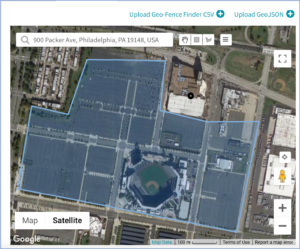Table Of Contents
- Geo-Fencing
- What Is It?
- What It Is Not.
- Competitive Conquesting
- Customer Loyalty Efforts
- Marketing Message Differentiation
Today’s retail landscape is highly competitive, with consumers spending more money online, retailers need to leverage all of the digital tools at their disposal to compete.
We believe Consumer action is the greatest indicator of intent. So on behalf of our clients, we leverage the “digital breadcrumbs” consumers leave online and off-line and target those who are most likely to need or want our Clients’ products and services. Geofencing is the primary tool we use to capture those digital breadcrumbs out in the wild (off-line). This article will provide an overview of how leveraging digital tools and tactics can help you grow your business and give you a competitive edge. First, let’s quickly talk about what geofencing is and is not.
What Is Geofencing Marketing?
Geofencing is a location-based technology that allows retailers to put a virtual fence around a physical building (brick and mortar location). We can then capture the mobile device IDs in the fence, and use that to serve them ads in the future. Here are definitions from other trusted sources. Techopedia, geofencing is described as “A technology that defines a virtual boundary around a real-world geographical area.” While Wikipedia defines it as a “Virtual perimeter for a real-world geographic area.” It’s not some complicated programming language or complex development tool. A geofence can be as small as an individual building or home and as large as a square mile. But it’s the placing of that defined boundary that makes geofencing possible. Below is an example of a geofence placed around Philly’s MLB stadium and parking lot in Philadelphia.

Geofencing Marketing Is Not?

- Geofencing Marketing is NOT Beacon Technology.
Beacon Technology is a more direct approach to advertising. Intellectsoft, a software development company explains “beacons use proximity technology to detect human presence nearby and trigger preset actions to deliver informational, contextual, and personalized experiences.” The technology consists of beacon devices located in indoor and outdoor positioning systems. One of the many advantages of geofencing marketing is its ability to scale. You don’t need to place beacons around your competitor locations with geofencing marketing compared with beacon technology.
If you’re interested in learning more about beacon marketing, click here.
- Geofencing Marketing is NOT Push Notifications.
Push notifications are a proponent of beacon technology. For example, let’s imagine a customer walks past an area with an Internet of Things (IoT) network or positioning system where beacons are established. With the consent of the customer, the closest beacon sends a message or code to their portable device. The message then pops up as a notification on a customer’s portable device with a third-party or branded mobile app. This process is more invasive and with privacy laws, it’s becoming more challenging to leverage push notifications with the consent of the consumer. A great example of this is the Apple IOS 14.5 Update.
- Geofencing Marketing is NOT SMS Text Messages
Compared to geofencing for mobile apps, SMS geofencing is different. SMS (Short Message Service) Text Messaging captures your cell phone number to send you messages approved by your cell phone carrier by a third-party or branded mobile app. In addition, it sends push notifications to your phone that allow you to tap URL links and see branded advertisements. Again, similar to push notifications this is even more invasive and has an impact on privacy.
- Geofencing Marketing is NOT Paid Search Text Ads

When you type something into Google Search Bar, the Search Engine Results Page (SERP) displays a list of results. You can view both organic listings and paid ads. Paid search results appear as promoted links at the top of the SERP. Paid search marketing allows firms to advertise in the sponsored listings of a search engine or a partner site by paying either per click (pay per click) or per thousand impressions (CPM or cost per thousand). However, geofencing marketing does not have our ads show up in the search results. Occasionally on the Google Doubleclick exchange, but not Google Search Results.
- Geofencing Marketing is NOT AdWords Geofencing
Google Ads is a Google-developed online advertising platform where advertisers can bid to have brief commercials, service offerings, product listings, or videos displayed to web users. Adwords provide an efficient approach for an advertiser to generate traffic to their website without having to acquire advertising inventory on other sites by matching relevant advertising material to the content on a publisher page.
If you’re interested in learning more about Google Adwords essential strategies, click here.
5 Useful Geofencing Marketing Strategies Retailers & Franchises Can Use
Competitive Conquesting
Through a strategy called “geo-conquesting.” Retailers can track customers of local competitive businesses within their service area and serve them ads to start the conversion process. Imagine you own a clothing store franchise. You can send offers to customers of other local competitors to have them come and visit your store.

Customer Loyalty Programs
Geofencing helps marketers understand the physical journey and experiences of their own customers as well. You can track the competitors’ locations where your customers also shop. This will allow you to make more specific offers. You can also send ads to your best customers to improve engagement and increase customer loyalty.
Using geofencing, loyalty cards may no longer be needed. Retailers can use data to target the most frequent customers. Another tactic may be to join up with other neighborhood non-competitive retailers to draw customers into a specific area where everyone can benefit. Like a bar offering a discount to folks who visit the local sporting arena.
Marketing Messages Optimization
We recommend running at least two ad messages to support each campaign. Via A/B testing retailers can optimize campaign performance. Below is an example from a prior client of ours who owns three RV dealer locations. A couple things to point out here.
- We set up each location as a conversions zone. We were able to track that our campaign drove 117 customer prospects into the three dealerships.
- We tested three different messages. There were dramatic differences between how each performed.
- Generic Dealership Message drove 17 visitors to showrooms.
- Bring your RV in for service drove 43 visitors to the showrooms.
- Bring your RV in for a trade-up drove 51 visitors to the showrooms.

With this retailers are able to directly measure which advertising campaigns were effective in driving customers in-store.
Conversion Zone Tracking – Walk-ins
Geofencing technology has improved significantly over the last couple of years, now we can put fences around individual buildings and set up conversions zone to identify exactly where customers coming into our client locations were identified. The below report is a snapshot from that same RV customer with three locations. We can see where the fences were set up and how many each location drove into their dealerships. Some drove none, like Camping World Bakersville. Pismo Creek RV resort drove the most with 35 visitors to client store locations.

Valuable Campaign Metrics
Geofencing campaigns also give us more metrics to track and optimize campaigns. We know the current CTRs average .01% to .03% depending on the category, the strength of creative, offer, and other relevant factors. The net of all that, digital display ads are like outdoor billboards we see along the way on highways. Over time there is a positive cumulative effect with prospects associating the services and products offered with your brand. We need to have two other metrics we use to evaluate campaigns. 1. View-to-visit, customers who saw your ads and come into your retail location. 2. Click-to-visit, customers saw and clicked on your ads and come into your retail location.
The sum of it all? Geofencing is one of the most effective tools that brick-and-mortar retailers should be using to super charge marketing campaigns. And we are here to help.

